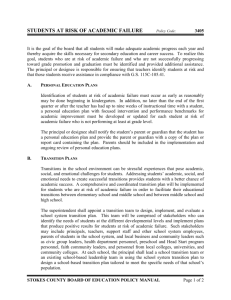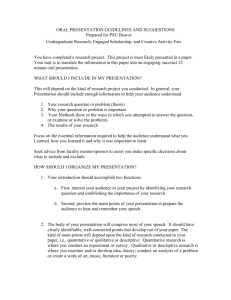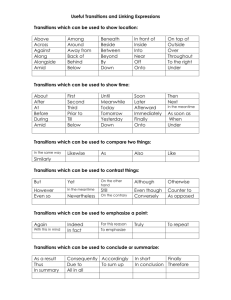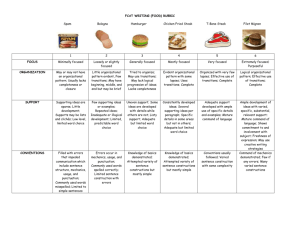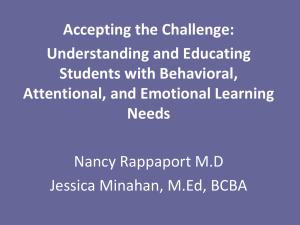Planning and Implementing Effective Group Time Activities chapter 4
advertisement
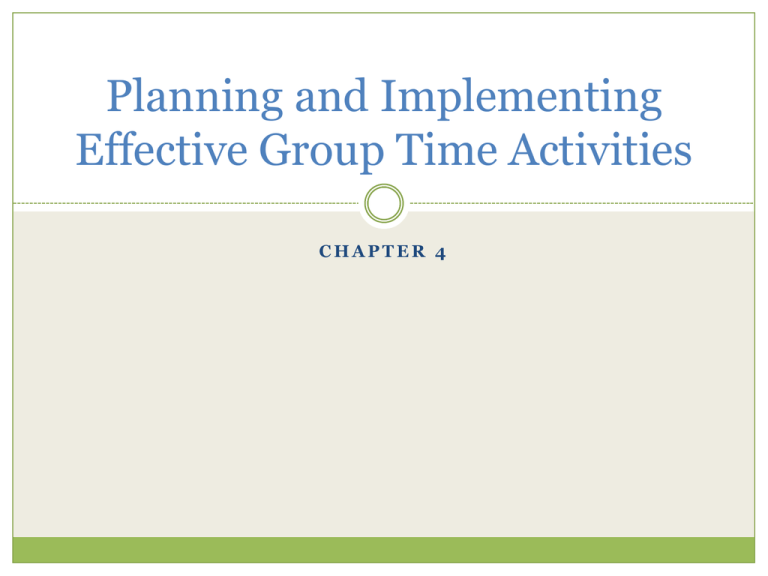
Planning and Implementing Effective Group Time Activities CHAPTER 4 Definition A time for all the children to gather and learn as a group from the teacher. The teacher is usally in control at this time. There is usally an exciting lure into the group time, and then through the use of songs, hands on activities, story and creative movement to reinforce, or introduce a topic. Kinds of Learners LOOKERS (do they have something to look at?) Listeners (is there something to hear?) Movers and Shakers (do they have something to do, or act out, or move some part of their body) We must plan for all children at our group time!! Four Parts of Group Time Opening Body Closing Transitions Opening Capture the children’s attention and get them engaged seating Carpet squares Shapes on floors All over the place In chairs ??? The Body Main purpose of the group time Props can be used Aspects of Group time Beginning Welcome (attention getter) Movement (at some point , even of their fingers if you don’t want whole body movement) Finger play/song (possibly to sing at the beginning of group time to signal that we are starting and eyes need to be on me!) Book (or flannel story, puppet, big book, pictures) Questions (thought through and open) Props (helps the visual learners) The Closing Very important to bring closure to the group time Review high points, but don’t go over and over. Transitions Definition: techniques used by teachers to get children and teachers from Point A to Point B smoothly and without incident. Kinds of transitions 1. Musical Transitions either playing music singing of a song 2. Cognitive Transitions take the form of directions that tie in with a type of perception or memory skill. Wearing red today What do we need to do next? What color leaf are you sitting on? 3. Physical Transitions move the children to the next area with some sort of physical skill tiptoe to the door slither like a snake (both cognitive and physical) 4. Creative Transitions these are often pretend type transitions make up a silly rhyme when you dismiss the children. 5. Pro social skills these would ask the children to find a friend to walk with concern what if they don’t have a friend or if there is an odd number of children, or if a child does not want to go with them Keys to success Provide a variety of experiences Topic Actions Involvement Questions Open ended Thought provoking Safe Impacting Quality of Responses Wait time Clarity Placement Calling on children in different ways Thought level Wait Time Increasing wait time increases number and quality of responses. Three second average 15 seconds is best Clarity Ask specific question, then stop talking. Avoid Unclear Questions For example “What about elephants?” would be a hard question to answer because the children would not know which direction the teacher was going with the question. Avoid Asking Series of Questions What do tigers eat? Do they eat plants? Would you find one attacking another tiger to eat it? If we ask too many questions at one time, then it becomes overwhelming and can we even remember the first question asked? Placement of Questions Before reading—to comprehend specific information During reading—to focus After reading—for general comprehension Methods of Calling on Children Solitary response (Jim, what is the date?) Controlled response (What is the date, Jim?) Uncontrolled response (What is the date?) Mass response (What is the date, class?) Thought Level WE need to take the developmental level of the children into place when we look at the thought level of the questions. Literal Interpretive Application Literal Read the actual words said. Is today Wednesday September 13th? Which is more a confirmation of the date and day of the week! “Does he love me?” Interpretation Read between the words Is today Wednesday September 13th? What is the teacher trying to say to me, did I forget something, am I not supposed to be here today? “Did he kiss me like he loves me?” Application Read beyond the words. Is today Wednesday September 13th? and as the Teacher and I reminding the student about their assignment that is due? “Will he ask me to marry— him?” Improving Questioning Wait time Clarity Placement Calling on children Thought level


